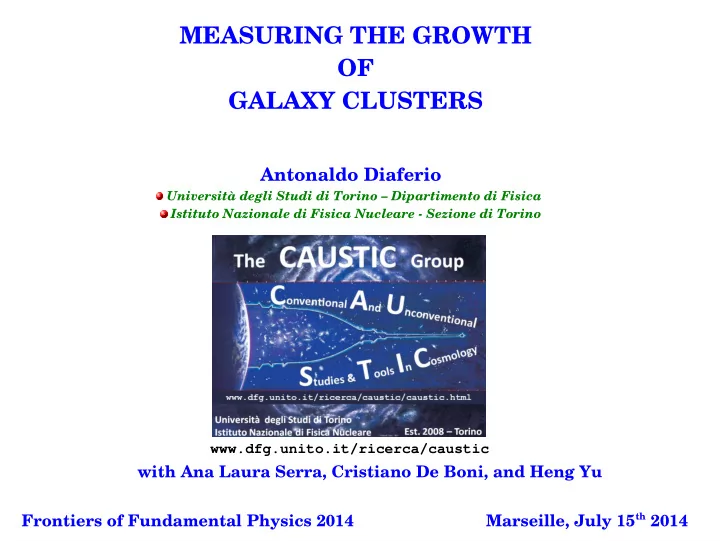

MEASURING THE GROWTH OF GALAXY CLUSTERS Antonaldo Diaferio Università degli Studi di Torino – Dipartimento di Fisica Istituto Nazionale di Fisica Nucleare - Sezione di Torino www.dfg.unito.it/ricerca/caustic with Ana Laura Serra, Cristiano De Boni, and Heng Yu Marseille, July 15 th 2014 Frontiers of Fundamental Physics 2014
OUTLINE The growth of structures on linear and non-linear scales Mass distribution within and around clusters Estimation of the mass in the outskirts of clusters and its connection to the mass accretion rate How well we can identify cluster substructures and surrounding groups and their connection with cluster formation Identification of cluster members and modified gravity
TESTING DARK ENERGY AND MODIFIED GRAVITY MODELS with lensing and/or redshift surveys Measuring the growth factor f ( z )= dln D γ ( z ) dln a =Ω 0 with γ =0.55 in GR. Measurable quantity β= f ( z ) in redshift surveys: b redshift distortion VIPERS (Guzzo et al. 2014)
STRUCTURE GROWTH ON NON-LINEAR SCALE The mass accretion history (MAH) in two interacting dark energy models CoDECS simulations (Baldi 2012) De Boni et al. in prep.
STRUCTURE GROWTH ON NON-LINEAR SCALE Different MAH's propagate into different mass functions CoDECS simulations (Baldi 2012) De Boni et al. in prep.
SUBSTRUCTURES IN GALAXY CLUSTERS DATA Ω =1 Ω =0.2 FLAT X-ray Geller and Beers 1982 Mohr et al. 1995 Richstone Loeb and Turner 1992
SUBSTRUCTURES IN GALAXY CLUSTERS Simulations Fraction of mass in substructures Lensing Fraction of mass in substructures Data Accretion time based on Lacey and Cole 1993 Smith and Taylor 2008
MASS DISTRIBUTION IN THE OUTER REGION OF CLUSTERS infall peculiar velocity: A539 Coma redshift A1367 A2670 projected radius Regös & Geller 1989
v z y x r v z x
THE CAUSTIC TECHNIQUE Example: Sky Redshift diagram CL0024 MASS ESTIMATE: Caustics Caustic amplitude = Escape velocity Diaferio & Geller 1997
MEASURING THE GRAVITATIONAL POTENTIAL PROFILE (unclean sample...!) Caustic potential/true potentia l 3000 synthetic clusters Λ ( CDM model) 68% Serra et al. 2011
MEASURING THE CUMULATIVE MASS PROFILE (unclean sample...!) 3000 synthetic clusters Λ ( CDM model) Caustic mass/true mass 68% Serra et al. 2011
CAUSTIC vs. LENSING MASS Caustic method: systematic Weak lensing: contribution overestimate at small r from large-scale structures (Serra et al. 2011) (Hoekstra 2003) Caustic/Lensing mass Lensing mass uncertainty Geller et al. 2013
THE TWO CLUSTERS MS0906 AND A750 1 Mpc
Caustics vs. Lensing Masses: the case of MS0906 + A750 Lensing mass of MS0906 (Hoekstra 2007) Caustic mass of MS0906 Caustic mass of A750 Geller et al. 2013
HeCS: The ultimate cluster mass I nfalling matter Λ in CDM M fin = 1.9 M 200 present time a=1 From HeCS y M ta = 1.99±0.11 M 200 t i c o l e future v l a=100 a i d a R M ta /M 200 Radial distance M 200 Busha et al. 2005 Rines et al. 2013
Measured accretion rate vs Expected accretion rate @ z~0 N-body simulations Data: CIRS 72 clusters @ z~0 d e r u s a e M Expected Expected Expected rate from 〈 dM / dt 〉∝ M 1.127 ( 1 + 1.17z ) E ( z ) the Millennium Sim. Serra et al. in prep. (McBride et al 2009)
Measured accretion rate vs Expected accretion rate @ 0.1<z<0.3 Data: HeCS 58 clusters @ 0.1<z<0.3 d e r u s a e M Expected Expected rate from 〈 dM / dt 〉∝ M 1.127 ( 1 + 1.17z ) E ( z ) the Millennium Sim. Serra et al. in prep. (McBride et al 2009)
ACCRETION WITH SURROUNDING GROUPS 7 clusters from the CLASH collaboration: Lemze et al. 2013
ACCRETION WITH SURROUNDING GROUPS simulations s s Satellite a m Identification: d 2D overdensity e t e r c c a f o n o i t 2D FoF c a r f satellite mass/cluster mass Lemze et al. 2013
SUBSTRUCTURES AND SURROUNDING GROUPS WITH THE CAUSTIC TECHNIQUE setting the thresholds binary tree simulated cluster
SUBSTRUCTURES AND SURROUNDING GROUPS WITH THE CAUSTIC TECHNIQUE recovery tests Yu et al. in prep.
SUBSTRUCTURES AND SURROUNDING GROUPS WITH THE CAUSTIC TECHNIQUE e t a r y r e v o c e r sample redshift range around the cluster center Yu et al. in prep.
IDENTIFICATION OF CLUSTER MEMBERS WITH THE CAUSTIC TECHNIQUE Completeness Contamination Serra & Diaferio 2013
CLUSTER VELOCITY DISPERSION PROFILE IN MODIFIED GRAVITY accurate measurement of velocity dispersion profiles velocity dispersion f(R)/GR A383 Lam et al. 2012 Geller et al. 2014
THE EQUATION OF STATE OF DARK MATTER By combining kinematic and lensing mass estimates (Faber & Visser 2006) w MACS1206.2-0847 Serra and Domínguez-Romero 2011 w=p/ ρ w Sartoris et al. 2014
SUMMING UP With the caustic technique we can: 1. Measure the mass in the cluster infall region 2. Identify the cluster substructures and surrounding groups 3. Measure the cluster accretion rate 4. Identify the cluster galaxy members TEST FORMATION OF GALAXY CLUSTERS AND MODIFIED GRAVITY MODELS
Recommend
More recommend